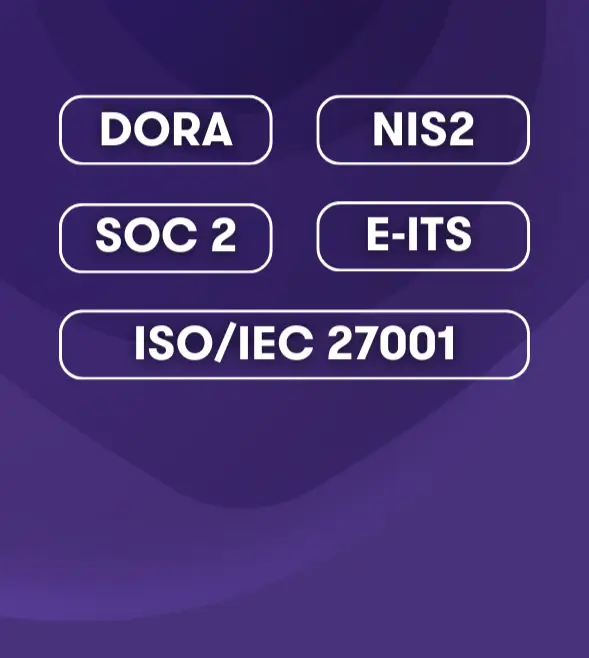-
Other audit services
We help clients with the application and use of foreign financial aid of EU and other funds and help prepare financial reports.
-
Audit calculator
The calculator will answer if the company's sales revenue, assets or number of employees exceed the limit of an inspection or audit.
-
Payroll and related services
We perform payroll accounting for companies whether they employ a few or hundreds of employees.
-
Tax accounting
Grant Thornton Baltic's experienced tax specialists support accountants and offer reasonable and practical solutions.
-
Reporting
We prepare annual reports in a timely manner. We help to prepare management reports and various mandatory reports.
-
Consolidation of financial statements
Our experienced accountants and advisors help you prepare consolidation tables and make the consolidation process more efficient.
-
Consultancy and temporary staff
Our experienced specialists advise on more complex accounting transactions, rectify poor historic accounting, and offer the temporary replacement of an accountant.
-
Outsourced CFO service
Our CFO service is suitable for companies of all sizes and in all industries. We offer services to our clients in the required amount and competences.
-
Assessment of accounting processes
We help companies to implement accounting practices that are in compliance with local and international standards.
-
Accounting services for small businesses
We offer affordable service for small businesses. We help organize processes as smartly and cost-effectively as possible.
-
Cryptocurrency accounting
We keep up with blockchain technology to serve and advise crypto companies. We are supported by a network of colleagues in 130 countries.
-
Trainings and seminars
Our accountants have experience in all matters related to accounting and reporting. We offer our clients professional training according to their needs.

-
Business advisory
We offer legal support to both start-ups and expanding companies, making sure that all legal steps are well thought out in detail.
-
Fintech advisory
Our specialists advise payment institutions, virtual currency service providers and financial institutions.
-
Corporate advisory
We advise on legal, tax and financial matters necessary for better management of the company's legal or organizational structure.
-
Transaction advisory
We provide advice in all aspects of the transaction process.
-
Legal due diligence
We thoroughly analyze the internal documents, legal relations, and business compliance of the company to be merged or acquired.
-
In-house lawyer service
The service is intended for entrepreneurs who are looking for a reliable partner to solve the company's day-to-day legal issues.
-
The contact person service
We offer a contact person service to Estonian companies with a board located abroad.
-
Training
We organize both public trainings and tailor made trainings ordered by clients on current legal and tax issues.
-
Whistleblower channel
At Grant Thornton Baltic, we believe that a well-designed and effective reporting channel is an efficient way of achieving trustworthiness.

-
Business model or strategy renewal
In order to be successful, every company, regardless of the size of the organization, must have a clear strategy, ie know where the whole team is heading.
-
Marketing and brand strategy; creation and updating of the client management system
We support you in updating your marketing and brand strategy and customer management system, so that you can adapt in this time of rapid changes.
-
Coaching and development support
A good organizational culture is like a trump card for a company. We guide you how to collect trump cards!
-
Digital services
Today, the question is not whether to digitize, but how to do it. We help you develop and implement smart digital solutions.
-
Sales organisation development
Our mission is to improve our customers' business results by choosing the right focuses and providing a clear and systematic path to a solution.
-
Business plan development
A good business plan is a guide and management tool for an entrepreneur, a source of information for financial institutions and potential investors to make financial decisions.
-
Due diligence
We perform due diligence so that investors can get a thorough overview of the company before the planned purchase transaction.
-
Mergers and acquisitions
We provide advice in all aspects of the transaction process.
-
Valuation services
We estimate the company's market value, asset value and other asset groups based on internationally accepted methodology.
-
Forensic expert services
Our experienced, nationally recognized forensic experts provide assessments in the economic and financial field.
-
Business plans and financial forecasts
The lack of planning and control of cash resources is the reason often given for the failure of many businesses. We help you prepare proper forecasts to reduce business risks.
-
Outsourced CFO service
Our CFO service is suitable for companies of all sizes and in all industries. We offer services to our clients in the required amount and competences.
-
Reorganization
Our experienced reorganizers offer ways to overcome the company's economic difficulties and restore liquidity in order to manage sustainably in the future.
-
Restructuring and reorganisation
We offer individual complete solutions for reorganizing the structure of companies.
-
Corporate taxation
We advise on all matters related to corporate taxation.
-
Value added tax and other indirect taxes
We have extensive knowledge in the field of VAT, excise duties and customs, both on the national and international level.
-
International taxation
We advise on foreign tax systems and international tax regulations, including the requirements of cross-border reporting.
-
Transfer pricing
We help plan and document all aspects of a company's transfer pricing strategy.
-
Taxation of transactions
We plan the tax consequences of a company's acquisition, transfer, refinancing, restructuring, and listing of bonds or shares.
-
Taxation of employees in cross-border operations
An employee of an Estonian company abroad and an employee of a foreign company in Estonia - we advise on tax rules.
-
Tax risk audit
We perform a risk audit that helps diagnose and limit tax risks and optimize tax obligations.
-
Representing the client in Tax Board
We prevent tax problems and ensure smooth communication with the Tax and Customs Board.
-
Taxation of private individuals
We advise individuals on personal income taxation issues and, represent the client in communication with the Tax and Customs Board.
-
Pan-Baltic tax system comparison
Our tax specialists have prepared a comparison of the tax systems of the Baltic countries regarding the taxation of companies and individuals.
-
Internal audit
We assist you in performing the internal audit function, performing internal audits and advisory work, evaluating governance, and conducting training.
-
Internal Audit in the Financial Services Sector
We provide internal audit services to financial sector companies. We can support the creation of an internal audit function already when applying for a sectoral activity license.
-
Audit of projects
We conduct audits of projects that have received European Union funds, state aid, foreign aid, or other grants.
-
Prevention of money laundering
We help to prepare a money laundering risk assessment and efficient anti-money laundering procedures, conduct internal audits and training.
-
Risk assessment and risk management
We advise you on conducting a risk assessment and setting up a risk management system.
-
Custom tasks
At the request of the client, we perform audits, inspections and analyzes with a specific purpose and scope.
-
External Quality Assessment of the Internal Audit Activity
We conduct an external evaluation of the quality of the internal audit or provide independent assurance on the self-assessment.
-
Whistleblowing and reporting misconduct
We can help build the whistleblowing system, from implementation, internal repairs and staff training to the creation of a reporting channel and case management.
-
Information security management
We provide you with an information security management service that will optimise resources, give you an overview of the security situation and ensure compliance with the legislation and standards.
-
Information security roadmap
We analyse your organisation to understand which standards or regulations apply to your activities, identify any gaps and make proposals to fix them.
-
Internal audit of information security
Our specialists help detect and correct information security deficiencies by verifying an organization's compliance with legislation and standards.
-
Third party management
Our specialists help reduce the risks associated with using services provided by third parties.
-
Information security training
We offer various training and awareness building programmes to ensure that all parties are well aware of the information security requirements, their responsibilities when choosing a service provider and their potential risks.
-
Digital Operational Resilience Act (DORA)
We will help you create a DORA implementation model that meets your company's needs and ensures that you meet the January 2025 deadline.

-
ESG advisory
We help solve issues related to the environment, social capital, employees, business model and good management practices.
-
ESG audit
Our auditors review and certify sustainability reports in line with international standards.
-
Sustainable investments
We help investors conduct analysis of companies they’re interested in, examining environmental topics, corporate social responsibility and good governance practices.
-
Sustainable tax behaviour
Our international taxation specialists define the concept of sustainable tax behaviour and offer services for sustainable tax practices.
-
ESG manager service
Your company doesn’t necessarily need an in-house ESG manager. This role can also be outsourced as a service.

-
Recruitment services – personnel search
We help fill positions in your company with competent and dedicated employees who help realize the company's strategic goals.
-
Recruitment support services
Support services help to determine whether the candidates match the company's expectations. The most used support services are candidate testing and evaluation.
-
Implementation of human resource management processes
We either assume a full control of the launch of processes related to HR management, or we are a supportive advisory partner for the HR manager.
-
Audit of HR management processes
We map the HR management processes and provide an overview of how to assess the health of the organization from the HR management perspective.
-
HR Documentation and Operating Model Advisory Services work
We support companies in setting up HR documentation and operational processes with a necessary quality.
-
Employee Surveys
We help to carry out goal-oriented and high-quality employee surveys. We analyse the results, make reports, and draw conclusions.
-
HR Management outsourcing
We offer both temporary and permanent/long-term HR manager services to companies.

-
Digital strategy
We help assess the digital maturity of your organization, create a strategy that matches your needs and capabilities, and develop key metrics.
-
Intelligent automation
We aid you in determining your business’ needs and opportunities, as well as model the business processes to provide the best user experience and efficiency.
-
Business Intelligence
Our team of experienced business analysts will help you get a grip on your data by mapping and structuring all the data available.
-
Cybersecurity
A proactive cyber strategy delivers you peace of mind, allowing you to focus on realising your company’s growth potential.
-
Innovation as a Service
On average, one in four projects fails and one in two needs changes. We help manage the innovation of your company's digital solutions!

Author: Kärolin Rohumäe, legal adviser
During the emergency situation in Estonia, many employers have allowed some or all their employees to work from home. Allowing people to work from home cuts the risk of contracting the virus, but also raises the question of who is responsible for providing a safe and healthy work environment for the employee.
The employer is expected to provide a safe working environment and occupational safety for employees. For example, it means that if an accident happens with a remote worker, it counts as an occupational accident and the employer is responsible for it. This responsibility cannot be laid on the employee. However, employers can ease the burden.
Below, I will discuss what kinds of measures the employer can adopt to ensure that its obligations to remote workers are met. Remote work is defined as performance of duties of employment outside the employer’s premises[1]. That doesn’t include only working in a home office but it could also mean working in a foreign country on agreement between parties (other than business trips). The parties to the employment contract must enter into a bilateral agreement in at least a form reproducible in writing either at the start of the employment relationship or during the employment relationship before the remote work starts[2]. In entering into the agreement on remote work, the employer assumes the obligation to provide the remote worker, among other things, with the following important factors:
- a safe working environment;
- occupational safety;
- up-to-datedness with information about work arrangements;
- sufficient work equipment;
- data protection and privacy.[3]
The Employment Contracts Act sets forth clearly that the employer is obliged to ensure the work conditions conforming to the requirements of the Occupational Health and Safety Act[4], among other things, the employee’s obligations in the field of occupational health and safety do not release the employer from responsibility. Agreements under which the employer is released from liability are thus in conflict with the law and null and void[5].
Employers have raised the question of how a safe environment can be ensured if the duties of employment are fulfilled in a setting outside the direct supervision of the employer such as at home, library or a cafe[6]. As it is not reasonable or even, in some cases, lawful to expect employers to physically check on the performance of work by remote workers, the employer must do all it can to make sure that the remote worker is aware of the rules of the working environment. For that reason, I recommend that every employer pre-emptively prepare an occupational environment risk analysis that sets forth the principles for performing remote work in the company.
Work environment risk analysis
Before allowing employees to start remote work, an occupational environment risk analysis must be performed.
Risk factors for remote workers may be working at display equipment or in an unnatural position for extended periods of time and changes in vision, headache and lowered work capacity, psychosocial risk factors, including working alone for extended periods and social isolation, overintensive work, working during the evenings and weekends, falling, electric shock and fire risk.
If the employer has performed a risk analysis and determined the main risks, the next step is to apply measures for preventing employee health risks.
Employees most often work remotely on a computer. Here the main risk factor is unnatural sedentary positions, which can lead to musculoskeletal disorders. The correct adjustment of monitors and lighting is also important to prevent visual acuity from declining.[7] To reduce risks, employees should be given instructions as to recommended positions and exercises; what the right lighting is, and how the computer, desk and chair should be positioned. If a remote worker lacks a computer desk or other equipment, the employer must provide it to the employee.
Guidelines for performing remote work
The goal of remote work guidelines is to explain safe work techniques for employees to avoid on-the-job accidents or professional diseases. It is also a good idea for the guidelines to also set forth other conditions for performing remote work. The guidelines must be available for all remote workers and it is recommended for the employee to be asked to confirm it with their signature. The guidelines should cover the following topics:
- What is remote work?
- How is remote work agreed between the parties?
- How will communication and division of labour between co-workers take place?
- How will working time be accounted for?
- What are the greatest risks (professional illness, on-the-job accident) in remote work, taking into account the risk analysis conducted by the employer?
- Psychosocial risk factors, including working alone for extended periods and social isolation, monotonous work etc.
- Description of suitable workplace (workstation, working on display equipment, adjustment of workstation).
- Recommended exercises.
- What work equipment does the employer ensure for the employee and how is it maintained and returned?
Before compiling the guidelines, I recommend reading the framework agreement on remote work prepared by the Estonian Employers Confederation and the Estonian Trade Union Confederation, in which they agree on the recommended principles for performing remote work.
Employees’ survey
Due to the current emergency situation, many companies have sent all of their employees to work from home. The situation is new for many and employers have not managed to devote attention to all of the nuances. To understand what employees need most to perform remote work (better exchange of information, work equipment etc.), I recommend conducting a survey to elicit feedback on the remote work arrangements. The objective of the survey is to offer all employees the possibility to give feedback on topics related to remote work, identifying the advantages and areas of concern. The survey gives the employer a clear view of what is going well and what could be better.
Although enabling remote work comes with certain risks, employees have a high regard for the possibility of remote work. In matters related to remote work, the experience labour law specialists at Grant Thornton Baltic can help: leading legal adviser Kristel Tiits kristel.tiits@ee.gt.com and legal adviser Lee Laanemäe lee.laanemae@ee.gt.com.
For more about remote work occupational environment and safety, read the article by Grant Thornton Baltic legal adviser Brigitta Jõgi, “Remote work – securely flexible?” .
Nothing in this alert should be construed as expert advice. This alert is a generalized summary. Professional counselling should therefore be sought before any action is undertaken.
[1] Ministry of Social Affairs. Occupational healthcare and safety for remote workers. (2019). P. 3.
[2] Estonian Employers’ Confederation and the Confederation of Estonian Trade Unions. Agreement on remote work, point 1.2. (2017). Retrieved: https://www.employers.ee/wp-content/uploads/Kaugtoo_raam-final.pdf.
[3] Estonian Employers’ Confederation and the Confederation of Estonian Trade Unions. Agreement on remote work, point 1.3. (2017). Retrieved: https://www.employers.ee/wp-content/uploads/Kaugtoo_raam-final.pdf.
[4]Employment Contracts Act, RT I, 19.03.2019, 94, clause 28 (2) 6).
[5] Ministry of Social Affairs. Occupational healthcare and safety for remote workers. (2019). P. 3.
[6]Intention to prepare draft amendment to the Employment Contracts Act and Occupational Health and Safety Act, p. 8.
[7]Ministry of Social Affairs. Occupational healthcare and safety for remote workers. (2019).









